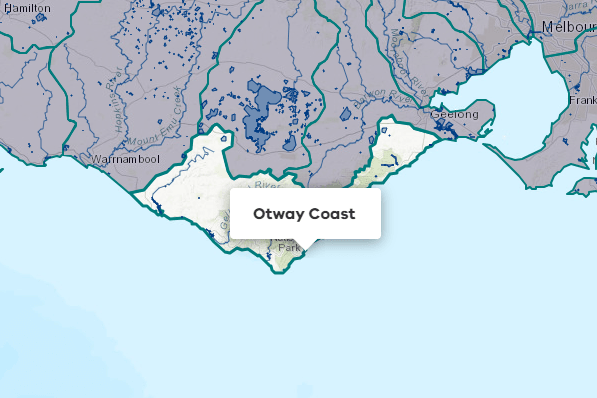About the area
- The Hopkins basin is in south-western Victoria. The two major rivers within the basin are the Merri River and the Hopkins River.
- The basin is predominantly flat terrain, except for low rolling hills in the north in the headwaters of the Hopkins River and Fiery Creek. The basin is largely cleared and used for agriculture.
- Average annual rainfall ranges from 400-900 mm in the basin.
More information on water management and accounting is detailed in Water .
2021-22 overview
Available water
Catchment inflow was similar to the previous year.
Licensed diversion restrictions
No change to restrictions on licensed diversions.
Water use
More water was diverted for consumptive purposes than the previous year.
When compared to the previous year, in 2021-22:
- lower rainfall was received, but catchment inflows were similar
- there was no change to restrictions on licensed diversions from unregulated streams
- about the same amount of water was diverted from the basin for consumptive uses.
Climate
Rainfall
The Hopkins basin received average rainfall in all areas except for a small area in the north near Beaufort where it was above average. Overall, rainfall was lower than the previous year.
River basin water balance
In 2021-22, 7,697 ML of water was diverted for consumptive uses: town, domestic and stock, irrigation and commercial supply, about the same as the year before (7,521 ML).
Water balance table
The table below shows the total volumes of water available and supplied from water resources in the Hopkins basin in 2021-22.
Table 1: Water balance, Hopkins basin
Catchment inflow
Catchment inflow represents the volume of water flowing into the waterways of a basin. It is calculated to be the difference between the total outflows and the known inflows.
Above average inflow received
Catchment inflow was 104% of the long-term average of 325,100 ML.
Similar to the previous year
This is similar to the previous year (112% of the long-term average).
Wastewater treatment plants
Water treated at wastewater treatment plants can be used to supplement water available in the basin. Water discharged to waterways from treatment plants is included as an inflow to the water balance.
Information on treatment plants is now reported in the Water Supply local reports for the water corporation responsible for managing the plant.
In this basin, wastewater treatment plants are managed by Central Highland , Grampians Wimmera Mallee , and Wannon .
Small catchment dams
Water harvested, used, and lost by small catchment dams (farm dams) is included in the water balance.
Table 2: Small catchment dams, Hopkins basin
Entitlements and compliance
Entitlements provide the basis for how water is shared in the basin.
GWMWater’s bulk entitlement to the Hopkins basin (Willaura, Elmhurst and Buangor) is reported in the Wimmera basin, as it covers water sourced from both basins, most of which is sourced from the Wimmera basin.
Entitlement volumes
Rights to water in the Hopkins basin are shown in table 3 below.
Entitlement volumes represent a maximum volume that can be taken in a one-year period. The volume available in a particular year is dependent on the rules for allocating water set out in the entitlement and the seasonal conditions in that year, which varies. The rules for allocating water under an entitlement can differ between entitlements and systems. This affects the ability and likelihood of water being taken in a particular year.
Table 3: Annual entitlement volumes at 30 June, Hopkins basin
Available water and take under entitlements
Total water available under entitlements represents the volume of water that was available to be taken by entitlement holders in 2021-22. The volume includes seasonal allocations and net trade into the basin.
Water taken
There was 2,944 ML taken under entitlements in 2021-22, about the same as the year before (2,837 ML).
Restrictions on licensed diversions from unregulated rivers
There were no restrictions on licensed diversions from unregulated streams in 2021-22 the same as the previous year.
Available water and take table
This table shows the volume of available water and the volume taken under entitlements in 2021-22.
Note that the allocation issued for take and use licences in the Hopkins Basin exceeds the take and use licence volume at 30 June 2022. This is a result of some licences being sold or transferred during the year, between the time of allocation issue and 30 June 2022.
More information on available water and take has been detailed in the How do we account for surface section on the How do we account for water page.
In 2021-22, about the same amount of water was taken under entitlements as the previous year.
Table 4: Available water and take, Hopkins basin
Compliance
Compliance against water entitlements is reported for this basin in three areas:
- entitlement issued: the volume of entitlements issued in a basin does not exceed formal caps, and has not increased without appropriate approvals
- water taken: the volume of water taken during the year does not exceed the volume considered to be available for consumptive and/or in-stream use during that year
- bulk entitlement provisions: holders of entitlements do not breach any provisions that are documented in their bulk entitlement orders.
Total entitlement volume
There was no net increase in the total entitlement volume from the previous year.
Total volume diverted
The total volume diverted (2,944 ML) was within the volume available for the year (17,976 ML).
Individual bulk entitlements
No individual bulk entitlement holder took more than the annual volume made available to them.
Exceptions to compliance
Individual bulk entitlement holders complied with all provisions in their entitlements.
Water for the environment
Environmental watering sites
There are no environmental entitlements in the Hopkins basin, so no active environmental watering occurs.
However, important sites in the Hopkins basin that depend on water for the environment include:
- coastal salt marsh wetlands and the wetlands associated with the Merri River estuary
- the Hopkins River, a major waterway draining the eastern part of the region and entering the Southern Ocean at Warrnambool
- Hopkins estuary, the Merri River and Fiery Creek
- Brucknell Creek and Deep Creek, which provide important fish habitat for species including the Australian grayling and river blackfish
- Mt Emu Creek, which contains reaches with relatively intact remnant riparian vegetation and deep, permanent pools providing drought refuge for threatened species.
Environmental water reserve
In 2021-22, water for the environment in the Hopkins basin comprised:
- water set aside for the environment through the operation of passing flow conditions:
- on consumptive bulk entitlements held by Central Highlands Water
- on licensed diversions, particularly for Cudgee and Mt Emu creeks
- all other water in the basin not allocated for consumptive uses: this water also provides social, recreational and cultural benefits.
Management responsibilities
Management of water in the Hopkins basin is undertaken by various parties
| Authority | Management responsibilities |
|---|---|
| Southern Rural Water |
|
| Wannon Water |
|
| GWMWater |
|
| Central Highlands Water |
|
| Glenelg Hopkins Catchment Management Authority |
|






